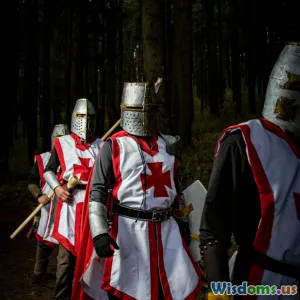
Why the Knights Templar Still Fascinate Historians Today
8 min read Discover the enduring allure of the Knights Templar and why historians remain captivated by this medieval order. (0 Reviews)
Why the Knights Templar Still Fascinate Historians Today
Few medieval orders have captured the imagination and dedicated scrutiny of historians quite like the Knights Templar. Founded in the crucible of the Crusades, this enigmatic group has emerged from historical records not only as skilled warriors and financiers but also as subjects of mystery, myth, and legend. Why, centuries after their dramatic fall, do historians continue to probe their origins, operations, and enigmatic disappearance? This article delves into the multifaceted allure of the Knights Templar, shedding light on the true nature behind the myths.
The Birth of a Medieval Military Order
The Knights Templar were established in 1119 by Hugh de Payens and eight other knights following the First Crusade. Their initial goal was straightforward: protect Christian pilgrims traveling to the Holy Land. Their early warfare prowess, religious dedication, and distinct white mantles emblazoned with the red cross quickly garnered them papal endorsement and privileges that few groups enjoyed.
Historians find the order’s inception particularly fascinating as it represents one of the first instances where military power was combined with monastic discipline. This dual identity as monks and knights challenges simplistic categorizations and demands nuanced historic analysis.
Considered pioneers in martial monasticism, the Templars effectively became the elite shock troops of Christendom, their military engagements altering the course of key battles during the Crusades.
The Knights Templar as Financial Innovators
Beyond their battlefield reputation, the Templars played a revolutionary role in medieval finance. They established an early form of banking, allowing pilgrims and nobles to deposit valuables in one location and withdraw funds elsewhere – a precursor to modern banking practices.
This financial acumen extended to land ownership and management. At their peak, the Templars controlled extensive properties across Europe and the Levant. They collected rents, invested in infrastructure, and even loaned money to kings and monarchies. Records from the 12th and 13th centuries reveal that monarchs, including England’s King John and France’s King Philip IV, found themselves indebted to this powerful order.
Historians are particularly interested in the Templars’ economic networks because they illuminate the development of international finance and the interplay between religion, warfare, and commerce during the Middle Ages.
The Dramatic Downfall and Mysterious Legacy
The suppression of the Knights Templar remains one of history’s most dramatic and controversial episodes. In 1307, King Philip IV of France, motivated by debts owed to the Templars and political ambitions, orchestrated a mass arrest of the order’s members on charges ranging from heresy to occult practices.
The infamous trials that followed resulted in the execution or imprisonment of many leading Templars, including their last Grand Master, Jacques de Molay. Pope Clement V officially disbanded the order in 1312 under significant political pressure.
Historians continue to debate the genuine substance of the accusations. Many view them as politically motivated tactics rather than evidence of wrongdoing. The intrigue surrounding their abrupt fall fuels ongoing research and reassessment, entwining judicial records, confessions extracted under duress, and surviving Templar documents.
This moment also spurs investigations into what happened to the order’s treasured assets and archives. Some believe that secret knowledge or wealth was hidden, feeding speculative theories which, while sometimes fringe, underscore a persistent desire to fully comprehend the Templar demise.
The Knights Templar in Modern Popular Culture and Historical Scholarship
The Templars' legacy blends historical fact with fiction, complicating scholarly efforts yet enhancing their cultural significance. The rise of conspiracy theories, novels, films, and video games — from Dan Brown’s "The Da Vinci Code" to countless other portrayals — has kept the group's mystique alive.
Historians approach these narratives critically, separating evidence-based scholarship from sensationalism. Publications like Malcolm Barber’s The Trial of the Templars and Helen Nicholson’s The Knights Templar: A New History employ rigorous analysis to demystify myths.
Moreover, archaeological discoveries, such as excavations at their former headquarters in Paris (the Temple), bring fresh insights on their daily lives and societal impact.
Why Historians Remain Fascinated Today
-
Complex Intersection of Faith, War, and Politics: The Templars encapsulate the volatile blend of spiritual zeal, military necessity, and political maneuvering characteristic of the Crusades era.
-
Pioneers in Financial Practices: Their trailblazing financial methods prefigure modern banking and economic structures, giving economic historians rich material.
-
Sensational Fall and Enduring Mysteries: The sudden, violent dissolution under questionable charges opens debates about power, justice, and historical memory.
-
Cultural and Symbolic Resonance: As symbols of chivalry, secrecy, and forbidden knowledge, they continue to serve as valuable case studies within cultural history and memory studies.
Conclusion
The Knights Templar remain an enduring subject of fascination thanks to their unique position as warrior monks, financial innovators, and victims of one of medieval history's greatest political intrigues. For historians, the Templars offer a remarkable lens through which to explore medieval society’s complexities—its spirituality, economics, and power struggles.
Far from being merely relics of a distant past, their story resonates today, urging scholars to continually probe beyond myth to understand the truths surrounding this legendary order. Through such efforts, we gain not only historical knowledge but insights into the human fascination with mystery, power, and legacy.
Quotes and further reading:
- Malcolm Barber, The Trial of the Templars, Cambridge University Press, 1978.
- Helen Nicholson, The Knights Templar: A New History, Sutton Publishing, 2001.
Real-world insight: In 2014, archaeological work under Paris’ Temple area uncovered sections of a Templar tower, sparking excitement about deeper understanding of their urban presence in medieval Europe.
Rate the Post
User Reviews
Popular Posts





















